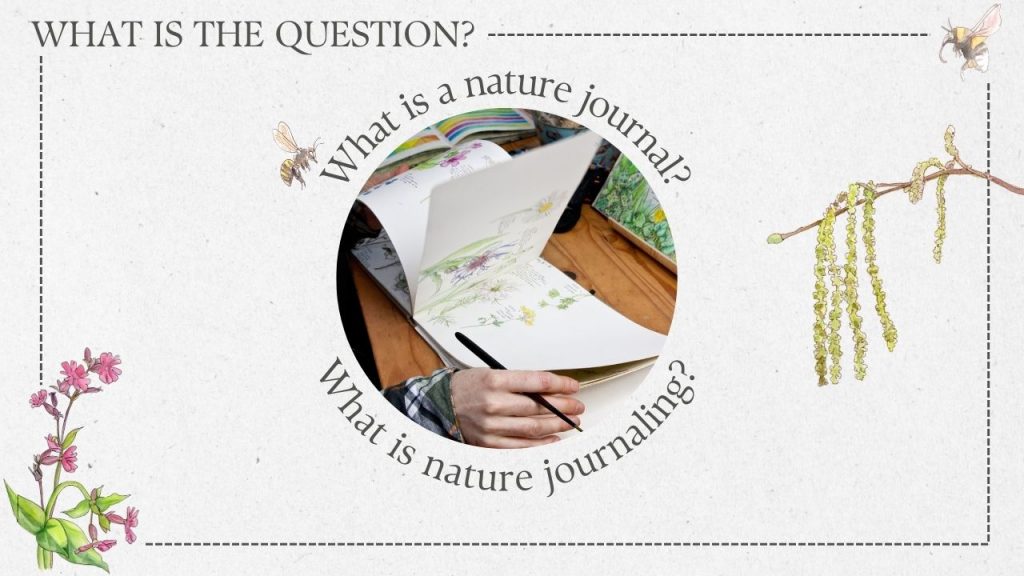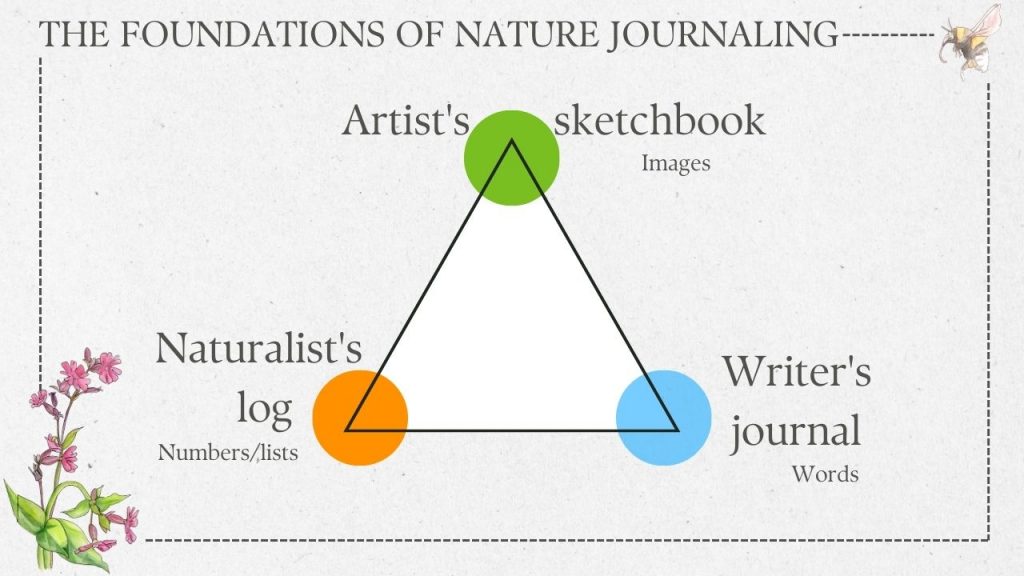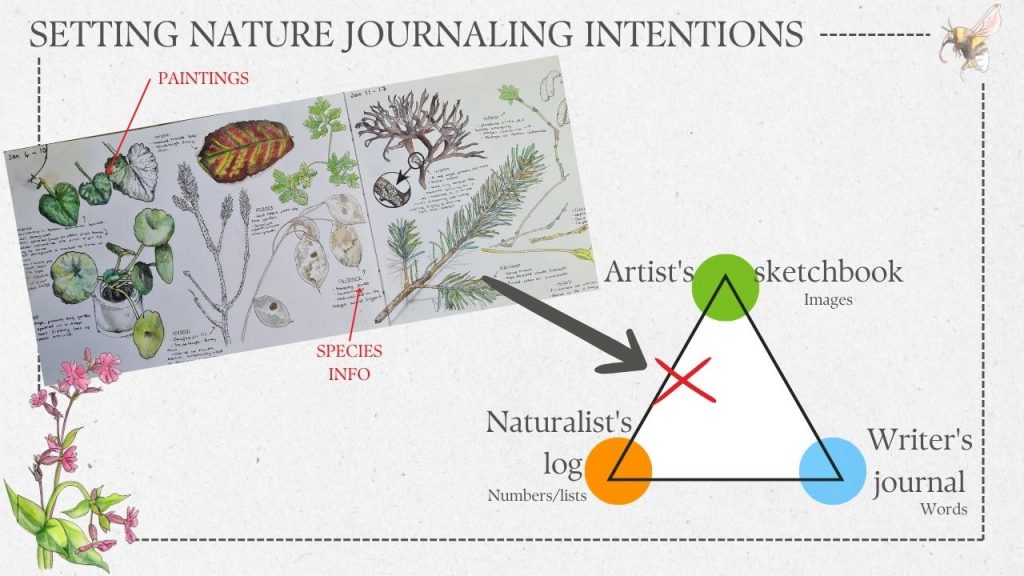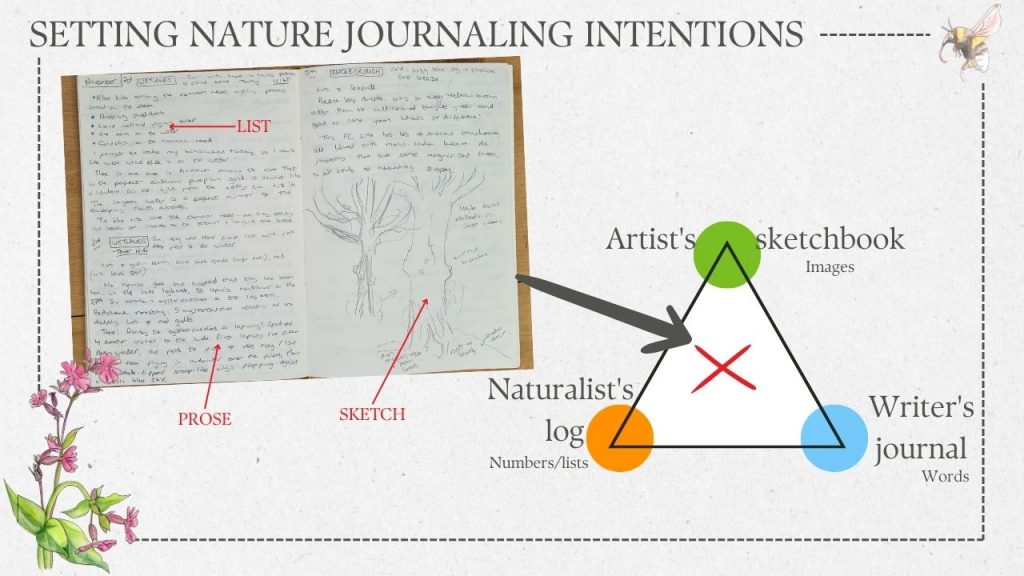I’m kicking off here for 2024 with the biggest question we can ask ourselves when taking up nature journaling. What is nature journaling? What is a nature journal? These are two very different questions – as the first refers to a process and an activity, whereas the second refers to an object or thing. Answering these questions for ourselves can be really useful to help set intentions and work out what it is we really want from starting nature journaling.
A very brief nature journaling history
Nature journaling has a long history. The nature journal was used by enthusiastic naturalists to document the world before the requirements of formal examinations, in times when an “amateur” naturalist was just “a naturalist”. These were people that were more interested in documenting the natural world than focusing on human progress or history. Prominent were also those who recorded nature as a part of their development in other fields, such as artistic or poetic skills. Every one developed some naturalist knowledge as a by-product of their focus on nature in their art.
Nature journaling was in existence for hundreds of years before anybody thought to start trying to define it. It has been known by many names, but is essentially journaling, diary-keeping, notebook-making, and sketchbooking by people who focus mainly on nature. It was largely taught to others by personal instruction rather than in books and came out of field arts in the sciences and nature sketchbooks or diaries in the arts.
The first definitions

Claire Walker Leslie was one of the first to publish an instructional manual to encourage anybody to nature journal. Her book “Nature drawing: A tool for learning” was published in 1980, based on skills she had learnt from other artists including Eric Ennion, John Busby, and Gunnar Brusewitz, who taught Leslie the combination of words and images for nature reporting. The first edition of Leslie’s “Keeping a Nature Journal” was published in 2000 and she defined nature journaling like this:
“Nature journaling is the regular recording of observations, perceptions, and feelings about the world of nature around you … the recording can be done in a wide variety of ways … there is no “correct” way to keep a nature journal. The success of a nature journal is in its flexibility and very personal intention.”
In 2016, in his book “The Laws Guide to Nature Drawing and Journaling”, John Muir Laws wrote the following:
“Keeping a nature journal is a way to rediscover the thrill of science … I draw and work in my nature journal for three reasons: to see, to remember, and to stimulate curiosity.”
No one definition was given of a nature journal or nature journaling within this book. Laws’ website gives the following definition:
“A nature journal is a lens that focuses our attention and crystalizes our observations, thoughts, and experiences. Nature Journaling is collecting and organizing your observations, questions, connections, and explanations on the pages of a notebook using words pictures, and numbers.”
The focus of the practice as taught by Laws is to develop curiosity, a scientific mindset, and naturalist skills.
In “Nature Journaling for a Wild Life” (2022) Roseann Hanson defines nature journaling in three levels.
“At the highest level [it is] deepening one’s understanding of nature through observation and recording. At an intermediate level [it is] a way of regularising our appreciation of nature as well as [building support for its conservation]. At its most intimate level [it is] a process that … enhances our own knowledge and boosts … well-being.”
If you know other books that have provided definitions, drop their names and definition quotes in the comments to further this discussion.
My definition – What is nature journaling?

“What is a nature journal?” and “what is nature journaling?” are two different questions requiring surprisingly different answers. The easiest of the two questions is probably the process-based one, “What is nature journaling?” After much thinking, I came up with the following.
“Nature journaling is the act of creatively recording your relationship with nature.”
This is a revision of my previous definition “Nature journaling is simply the act of keeping a journal that has a strong, but not necessarily exclusive, focus on nature.” Why did I change it?
Well, because I think that the older definition leaves out two important things creatively and recording your relationship with nature.
I think creativity is critical to what nature journaling is. It takes nature journaling away from lists of field observations produced by naturalists (though these are, of course, laudable) by adding an element of creativity. It reintroduces ‘the self’ into the record. It doesn’t matter how creative the nature journaling is, as the level of creativity introduced depends solely on the nature journaler’s background (for example, whether they were an artist or writer already before they started) and their approach/intent (for example, whether they are intending to use nature journaling to improve a creative skill). Rather, it just requires some element of creativity to be present: inclusion of some element of the creative arts. For example, sketching, painting, scrapbooking, collage, prose writing, poetry etc.
The second part is “recording your relationship with nature”. In my mind, this is absolutely the most important part of what nature journaling is. It differentiates it from scientific field arts, which seek to remain entirely objective and usually to exclude the subjective self and its likes, dislikes, and aesthetics entirely. Although there may yet be a scientific slant to one’s nature journal (again based on background and approach/intent), the self may be included by asking questions. For example, John Muir Laws’ “I notice, I wonder, it reminds me of” (note the emphasis on “I” here). Or, the journal could be much more personal. Perhaps it could take the form of a written reflection each day of how the weather affects your mood, how getting outside helps you manage depression and anxiety, and the nature that you see. Examples of this in the nature writing genre are “Wild Remedy” by Emma Mitchell and “Nature Cure” by Richard Mabey. Artistic expression through words or pictures is an ancient part of being human and bringing that expression to recording nature just deepens your connection with it.
I will also mention that in my definition, when I refer to “your relationship with nature”, I am not talking about something abstract. I am not talking about reading books about some species that exists on the other side of the world and copying someone else’s photos from the internet. Although such activities are great skill development, and very useful, developing “your relationship with nature” is about making time for the nature that exists close to you. It doesn’t matter if you live in an urban area. There will be something, and the more you begin to notice, the more you will find. I live in a rural area, but I am quite able to nature journal on trips to London and enjoy doing so. There is much more to this topic of developing a relationship with nature in your locale, but I’ll leave that for future blogs.
My definition – What is a nature journal?
For my online course “How to Start a Nature Journal” (BTW, you can grab the illustrated guide to this course here) I developed the following graphic to explain what a nature journal can be.

I stick to this graphical definition whenever I try to answer “what is a nature journal” because I just think this question is better answered with a picture than with words. Each point of the triangle is one of the three “foundations” of nature journaling. I believe that these three foundations encapsulate entirely what a nature journal can be. Images, words, lists. Here expressed as: a sketchbook, a naturalist’s field log, and a written journal. Think of the interior of the triangle as a map. You can “plot” your current or desired nature journal onto this map.
For example, this nature journal of mine fits best down in this part of the map. It is mainly written reflection and hand-drawn images. It doesn’t have much in the way of naturalistic records, just a few species names, and sits more on the creative than the scientific scale.

As another example, this nature journal doesn’t have much writing, but is a record of local plant species, presented in a perpetual journal style, over several years. It is mainly paintings and naturalistic records, so it sits over here.

My outdoor field journals sit in the middle, as I try to balance sketches, lists, and writing in these books.

So you see how this triangle acts as a map to help you set your intentions around nature journaling? Notice that this definition says nothing at all about the medium used or what the nature journal consists of. Most people, when thinking about nature journals, envisage a sketchbook. But there are ways to keep a nature journal that do not use a sketchbook at all. For example, I interviewed Mary Truell in this video. She is a remarkable woman for her nature conservation work and fundraising, and started nature journaling at 91 years old! She uses loose sheets of paper to write her journal, which she compiles with scrapbook materials into a big photo album. Nature journals can also be postcard boxes or trinket boxes, or any number of inventive physical objects.
We also live in a digital world too. A nature journal could be a blog. It could be an Instagram grid. In these cases, the nature journal has no physical form at all, but exists digitally, describing the real world outside. When creating my nature journal for 2022, I couldn’t stop wondering whether the nature journal was the physical book or the series of videos about the book! Digital projects can still be put into the triangle, taking the “sketchbook” corner to mean “images”, the “written journal” corner to mean “words” and the “naturalist’s log” corner to mean “nature records”.
There we have it then, my definitions of what nature journaling is and what a nature journal is. What do you think? Do you agree or disagree with my definition? Come and join the discussion inside the free Nature Journaling Circle community.
Like the idea of nature journaling and want to learn more? The Nature Journaling Circle membership is a welcoming space for you to learn nature journaling with me and join the community of lovely nature journalers from around the world walking this path. There’s a monthly live tutorial and a social session, plus access to all my pre-recorded video courses. If that’s something you might be interested in, please consider joining us here.



